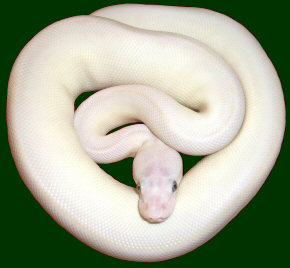

Description
 This is a small species by python standards averaging only around three feet in length with exceptional specimens approaching five feet in length. The record length for the species is around six feet in total length. This python has a robust build in relation to its length with
This is a small species by python standards averaging only around three feet in length with exceptional specimens approaching five feet in length. The record length for the species is around six feet in total length. This python has a robust build in relation to its length with  females in particular achieving considerable girth. Size and mass are sexually dimorphic to some extent with female averaging larger sizes and heavier weights than males of similar age.
females in particular achieving considerable girth. Size and mass are sexually dimorphic to some extent with female averaging larger sizes and heavier weights than males of similar age.
Ball pythons are tremendously variable in terms of color and pattern with wild specimens typically clad in shades of gold, brown and black.
Habitat
_thm.jpg) Python regius is most often associated with the central African savanna. This python is usually found in grassy areas, open woodland and on agricultural land. Though this is primarily a denizen of grassy areas there have been numerous reports of ball pythons found in wooded and even the rainforest areas which lie to the south of their traditional savanna habitat. The climate and habitat of this entire region is changing rapidly. The natural process of desertification in which the Sahara expands southward, has been accelerated by human activities such as deforestation for building material and fuel. As a result of these processes, many areas that were heavily forested just decades ago are now grassland or agricultural land. This shift from forest to human modified habitat seems to have expanded the western portion of the range of Python regius. In other areas the southward expansion of the Sahara has reduced the amount of suitable habitat for this species.
Python regius is most often associated with the central African savanna. This python is usually found in grassy areas, open woodland and on agricultural land. Though this is primarily a denizen of grassy areas there have been numerous reports of ball pythons found in wooded and even the rainforest areas which lie to the south of their traditional savanna habitat. The climate and habitat of this entire region is changing rapidly. The natural process of desertification in which the Sahara expands southward, has been accelerated by human activities such as deforestation for building material and fuel. As a result of these processes, many areas that were heavily forested just decades ago are now grassland or agricultural land. This shift from forest to human modified habitat seems to have expanded the western portion of the range of Python regius. In other areas the southward expansion of the Sahara has reduced the amount of suitable habitat for this species.
Within their typical savanna habitat ball pythons are often encountered in subterranean burrows, emerging only at night to search for prey. This is considered to be a terrestrial species and its body structure supports that fact. Though adults are primarily terrestrial there are many reports of wild specimens both adults and juveniles being encountered in trees and in some areas even consuming avian prey.
Distribution
 Ball pythons are distributed in a somewhat narrow belt of suitable habitat which occurs along the southern border of the Sahara desert. This range includes portions of at least 20 countries and stretches from Senegal in the west to the Sudan and Uganda in the east. The eastern portion of their range may even be disjunct from the better known western population. Barker and Barker (2006) raise the possibility that the easternmost populations in Sudan and Uganda may be geographically isolated.
Ball pythons are distributed in a somewhat narrow belt of suitable habitat which occurs along the southern border of the Sahara desert. This range includes portions of at least 20 countries and stretches from Senegal in the west to the Sudan and Uganda in the east. The eastern portion of their range may even be disjunct from the better known western population. Barker and Barker (2006) raise the possibility that the easternmost populations in Sudan and Uganda may be geographically isolated.
Projects
I am currently working with several mutations and combinations including: Albino, Pied, Pastel, Mojave, Butter, Granite, Cinnamon, Yellow Belly, Red Axanthic, Black Pastel, Ghost, Pinstripe and Enchi.
